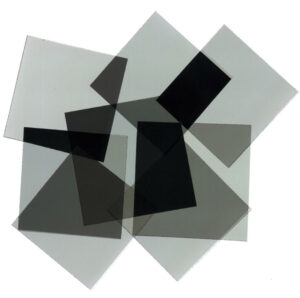5.3.2: Crossed Polars
- Page ID
- 18976

Suppose light passes through a polarizing filter that constrains it to vibrate horizontally (Figure 5.19). (In this figure, we only show two of the many vibration directions in the unpolarized light but think of vibrations occurring in all directions.) On the other side of the first filter, the polarized beam, although perhaps decreased in intensity, appears the same to our eyes because human eyes cannot determine whether light is polarized. If, however, a second polarizing filter, oriented perpendicularly to the first filter, is in the path of the beam, we can easily determine that the beam is polarized. If the second filter allows only light vibrating in a north-south direction to pass, no light will pass through it.

Figure 5.20 shows some polarizing filters piled randomly on top of each other. In some places the filters are at 90o to each other and no light gets through. In other places they transmit lots of light. (These filters have a gray color and absorb some light, so we do not see any white light being transmitted no matter the orientation of the filters.) But, when the filters are aligned we get maximum light transmission, and when they are perpendicular we get none.


